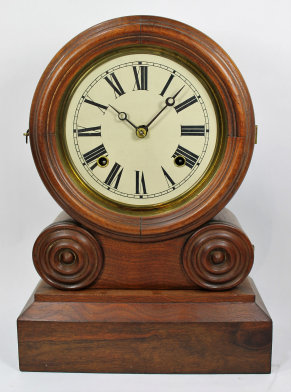
603. $750
Ithaca “Index”, ca. 1875. There are several versions of the “Index”, this being the most common. They differ in the top piece. The walnut case is 31.5 inches high, clean and unmarred. There are carved incisings on the
door and dial boards. The calendar dial indicates that it was made for Lynch Brothers, who I believe were clock
retailers; the time dial is new. The glass is original but the Index lettering is worn. The unsigned 8-day movement is
running, keeping time, striking the hours on a large nickel bell, and the calendar is advancing. $750-$1000.

604. $500
Jeromes’ and Darrow 8-Day wooden-works clock. The mahogany veneer case is just under 38 inches high
with carved half-columns. There is a wooden dial in nice shape (although it has been secured to the support rails by screws
for a long time) and two old and correct hands. The dial glass is old but may have been replaced, based on the newer (but still
old) putty holding it in place. The lower glass is also old and may never have been out of the door, based on the unusual rippled
wood strips holding it in place. It has been repainted, some time ago, and is not signed. The center mirror is a twentieth
century replacement. There are numerous veneer repairs, some good, some not so good, and some chips still waiting for repair. The carved columns are in excellent shape. The large wood movement will run for a few minutes when the 12-lb square Jerome weights
are hung; I see no repairs or damage to the gears. The weights are compounded on brass pulleys, hung on gut, and there is an
old pressed pendulum bob. There is even an old key to open the door latches. The tablet, and the overall look of this
clock are very nice, don’t you think? $500-$700.
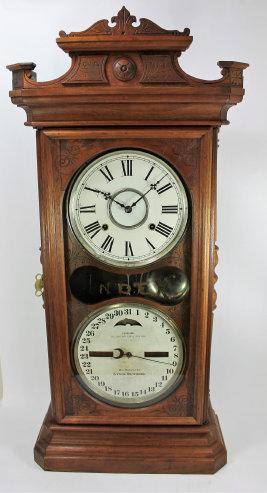
605. $75
Waterbury “Commodore” clock and barometer, ca. 1929. Two ship’s wheels holding an 8-day jeweled
movement (as indicated on the dial) and a barometer. There is a mercury thermometer in the middle. The brass stand is
9.25 inches wide, 2.75 inches deep, and 6.5 inches high, designed to sit on your desk on small ball feet. The brass finish could
stand to be polished, and there are some spots of corrosion, especially on the sides of the supports. Fortunately, they are
not very noticeable. The silvered dial on the clock shows some tarnish and wear; both dials sit behind beveled glasses. We had the clock running when it was out of the stand, but can’t get it running now. You wind it by turning the pilot wheel,
but I’m not sure which way works. There is a lever you lift up to adjust the time by the same mechanism. Not sure the
barometer is working fully either. Well, the thermometer is correct. $75-$125.
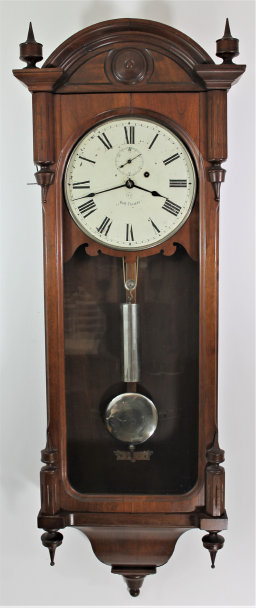
606. $1500
Seth Thomas “Regulator No. 6”, ca. 1880. A walnut case with an old finish and nickel trim including
the damascened pendulum bob, weight, and pulley. The dial holds the original paint with some flaking and wear but is remarkably
good for a Thomas dial. The hands are correct; the beat scale is correct but the finish is worn, and there is a dent in the
bob. All the finials are correct although the bottom center finial looks like a replacement. The door glass is old and
wavy but one retaining strip is newer. The veneer on the shaped base has some problems and has been partially replaced on both
sides. You’ll need to get down on your knees to see the flaws, or look at the provided pictures. The time-only 8-day movement
is unsigned and is running and keeping time. There is no label. We sold a very similar example in 2016 for $2500. $1600-$2000.
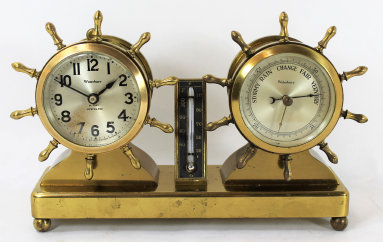
607. $100
Sessions “Regulator H” calendar, ca. 1908. A nicely refinished store calendar, 35.5 inches
high in oak, as is typical. The dial glass is new, as is the dial pan and signed paper dial. The lower glass is old. The hands and pendulum bob are not Sessions issue for this clock. The 8-day time-only movement is signed but is in need of cleaning
and probably rebushing; we cannot keep it running for more than a few minutes. $150-$200.
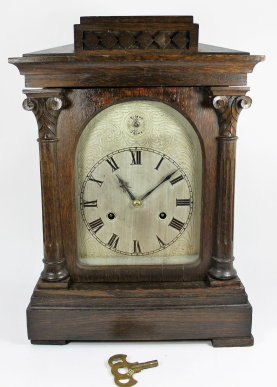
608. $75
English Bracket Chime clock, ca. 1900. A 16-inch-high bracket
clock in a dark oak finish with a four-rod chime. The oak case is in good shape but the left front foot is either broken off
or a replacement. The silvered dial shows modest wear. We cannot get it running but did not remove the movement from the
case. One of the hammers for the 4-rod chime is missing; hammers of various sizes can be purchased from TimeSavers for $1.50. No label and no signature on the movement or dial. If you’re a chime clock collector this is a good buy as it should be easy
to get running. $100-$250.
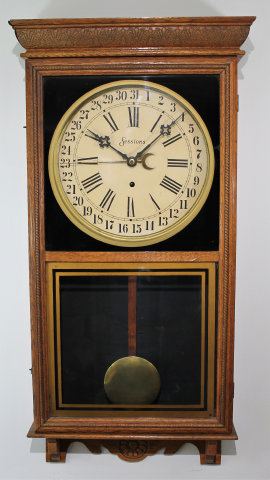
609. $675
Waterbury “Regulator No. 54”, ca. 1915. An 8-day, time-only, two-weight-driven regulator in
quarter-sawn oak, with a clean medium oak finish. This is a big clock, 57 inches high with a 12-inch repainted dial with the
Waterbury logo. The signed, time-only movement is shown on page 189 of Ly’s book on Waterbury clocks, dead-beat escapement with
retaining power. The brass weights look correct but the bob is not Waterbury issue. The hands are Waterbury stock, including
the seconds hand. The top finials may be replacements but are good matches to the catalog example. No label is evident. The clock is running and keeping time. Two sales in the Antique Clocks Price Guide from 2014 at $800 and $1200, and one sale
on eBay, 2014, at $1225. We sold one in 2015 for $1585. $750-$1000.
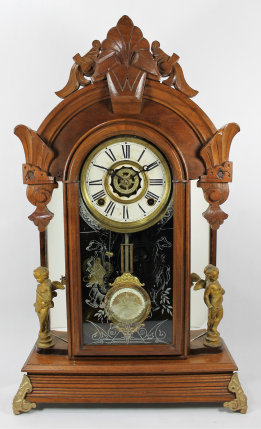
610. $150
Ansonia “Windsor”, ca. 1880. Ansonia made two mirror-sided shelf clocks, the Triumph and this
one, the Windsor. The black walnut case is 21.5 inches tall and 13 inches wide, slightly smaller than the Triumph. Both
are shown on pages 445 and 447 of Ly’s book on Ansonia clocks. This Windsor has a mirrored glass pendulum although the mirror
surface is oxidized behind the glass. The side mirrors are probably replacements; the door glass and the cupids are probably
original. The glass has lost much of its stenciled design from overzealous cleaning. Note the two front corner metal feet. The signed 8-day time-and-half-hour strike movement is running and keeping time. This clock also has an alarm which we did not
test; there is no label to be found. The glossy paper dial shows some foxing. A Windsor sold on eBay last year for $228. $200-$250.
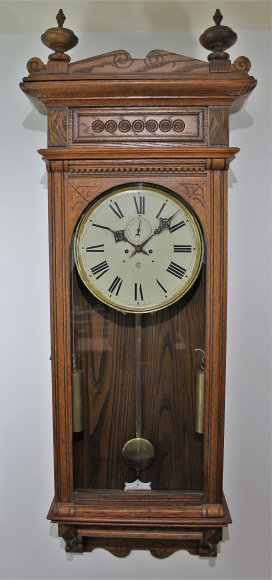
611. $125
Ingraham “Grecian”, ca. 1869. The ever-popular Grecian, a 14.25-inch walnut case with
rosewood veneer, a new paper dial in a brass bezel, old glass and appropriate hands. The finish is very good. The 8-day
time-and-strike signed movement is running, striking a wire gong and keeping time. Good green label inside. $150-$250.
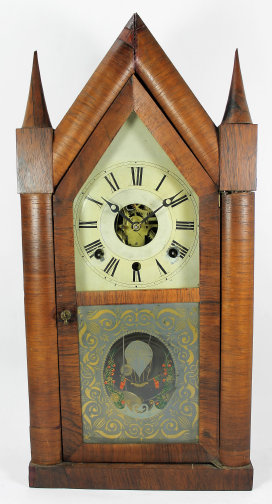
612. $150
Chauncey Boardman fusee steeple, 1847-1850. Boardman with Joseph Wells received a patent
in 1847 on a “reversed fusee” movement in which the spring and fusee are mounted on the same shaft, as found here and imprinted on
the signed movement. They broke up their partnership in 1844 and produced clocks independently; Boardman died in 1857. This 30-hour movement originally had an alarm but the mechanism has been removed. The green label is very dark but “Chauncey
Boardman” is visible under the right lighting. The painted dial is likely original and has been touched up; both glasses are
very old, the tablet showing a balloon with American flags on either side. The veneer on the 20-inch case is good, with a repair
or two; some veneer is missing at the peak. The clock is running and striking. Fusee steeples by this maker routinely
sell on eBay in the mid-$200’s. $200-$300.
